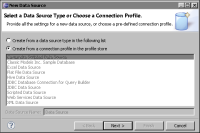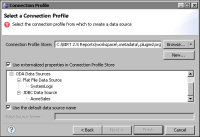Using a connection profile
You have the option of creating a new data source using information stored in a connection profile. Using a connection profile saves time and reduces the potential for connection errors because all you need to do is supply the location of the profile. You do not need to know or remember all the required connection information, and, presumably, the connection profile has been tested. To use a connection profile created by another report developer, make sure you get the location of the profile.
How to create a data source that uses a connection profile
1 In Data Explorer, right-click Data Sources, then choose New Data Source.
2 In New Data Source, select Create from a connection profile in the profile store, as shown in
Figure 1‑5. Choose Next.
Figure 1‑5 Creating a data source that uses a connection profile
3 In Connection Profile, in Connection Profile Store, specify the location of the file that contains the connection profiles. You can choose Browse to find and select the file. As described in the previous topic, the default file name is ServerProfiles.dat, and BIRT saves this file, by default, in the .metadata folder in the workspace in use when the connection profile was created. The default path is
...\workspace\.metadata\.plugins\org.eclipse.datatools.connectivity\ServerProfiles.dat
4 After you specify the location of the .dat file, Connection Profile displays all the available profiles.
Figure 1‑6 shows an example of two connection profiles, SystemLogs and AcmeSales.
Figure 1‑6 Connection Profile displays two predefined profiles
5 Select the connection profile to use.
By default, Use the default data source name is selected. If you selected the SystemLogs profile, the new data source is also named SystemLogs by default.
6 Optionally, specify a different name for the data source.
7 Choose Next. New <data source type> Data Source Profile displays in read-only text the connection information derived from the connection profile.
8 Choose Finish. The new data source appears under Data Sources in Data Explorer.


